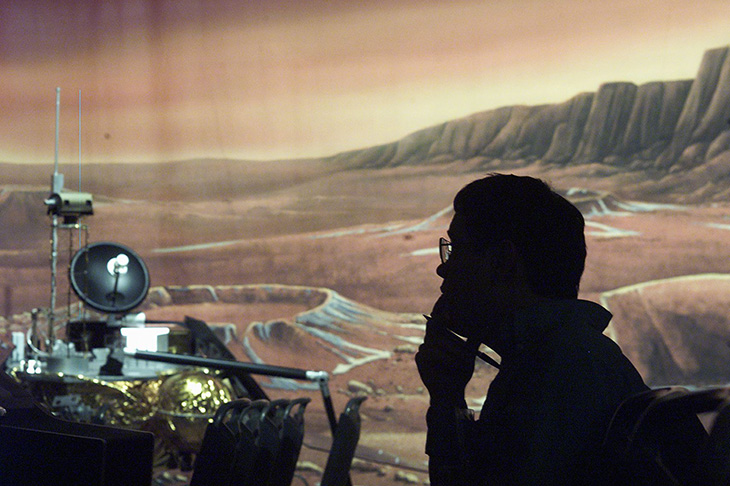Apparently the first audio message broadcast into space with the ostensible purpose of communicating with aliens was the sound of vaginal contractions in ballerinas. According to Daniel Oberhaus’s Extraterrestrial Languages, the artist Joe Davis beamed the information from an MIT radar installation towards the stars Tau Ceti and Epsilon Eridani in 1985. A USAF colonel shut the transmission down when he discovered what the content was. Never mind the difficulties of communicating with aliens; sometimes it’s pretty hard to understand what’s going on in the minds of humans.
The question of how we’ll talk to extraterrestrials, as and when we eventually find some, is an old one. Oberhaus, a writer at Wired magazine, finds examples as old as 1638. The protagonist of The Man in the Moone, a novel by Francis Godwin, meets lunar aliens after being flown there by some swans, and is baffled by their language which ‘consisteth not so much of words and letters, as of tunes and uncouth sounds, that no letters can expresse’.
By the 19th century, when the solar system was better mapped out, there were more serious discussions of ways of sending messages to Martians or others: great pits filled with fire, or enormous mirrors to reflect light. The mathematician Carl Gauss proposed building a massive visual proof of Pythagoras’s theorem, a right-angled triangle bordered by squares, out of rows of trees in the Siberian tundra.
Oberhaus explains some of the difficulties of messaging aliens. First, since it’s become fairly obvious that there are none in our solar system, it’s not going to be a case of mutual discovery. When humans learn languages from each other, as children or adults, there is prompt feedback — ‘cow?’ ‘vache!’, and so on. But if we broadcast our message into the cosmos, there’d be no chance of a reply for decades.
So, any message that we send has to hold the key to its own translation. There have been attempts to build messages like that, using what are hoped to be universal truths, such as the simple natural numbers, or the harmonic frequency of hydrogen. The Pioneer spacecraft carry gold plaques which have on them diagrams of the hydrogen atom and the locations and rotational periods of several pulsars. The idea is that, using the frequency of the atom as a yardstick, aliens would be able to identify the pulsars, and from them triangulate the location of the Earth. Others have tried to construct whole logical languages by starting with simple beeps — one beep, two beeps, three and so on — and then putting them in groups to show addition and subtraction, and from there building up to complex language.
It all assumes that things such as mathematics are indeed universal — that ‘one’ and ‘two’ are concepts that any intelligent being will understand. Oberhaus’s book gets fascinatingly philosophical about that — is ‘mathematical Platonism’, the idea that mathematics is real and exists outside our heads, necessary for human–alien communication to work? Marvin Minsky, the AI pioneer, also asked (and answered in the affirmative) whether aliens would have concepts such as ‘thing’, ‘object’ and ‘cause’.
There are other difficulties. For one, broadcasting is energy-expensive. Using a radar dish to broadcast a clear signal 100 light years, says Oberhaus, would take around 0.5 per cent of the Earth’s global energy production. There are less costly ways of doing it, but none of them are cheap. And, Oberhaus points out, we share our planet with some sapient beings — chimpanzees, dolphins — and while we can sometimes train them to use a few words of English, no one (as Carl Sagan said) understands a word of ‘dolphinese’.
Extraterrestrial Languages is not light; published by the MIT Press, it reads like an academic work. I was surprised, after finishing it, to discover that Oberhaus was a science writer and not an academic himself. But it is worth the effort, not least because it shows how many areas of thought the seemingly simple question ‘how do we communicate with aliens?’ touches on: Chomskyan linguistics, physics (microwaves would be the best medium, because they get through the atmosphere, and the galaxy’s background noise is quietest in those wavelengths), and existential risk (Martin Ryle, the former Astronomer Royal, warned that broadcasting our position to the universe might be the equivalent of shouting in a jungle), to name three.
Of course, the real question is whether any aliens are listening. And Oberhaus worries that, even if they are out there, they may not be. If extraterrestrial alien-hunting programs are anything like ours, he says, they ‘will be constantly on the verge of running out of funding and will only watch around 1 percent of the spectrum in a narrow portion of the sky’. It may be tExthat we can send as many audio recordings of vaginal contractions as we like, and the aliens will remain oblivious.
This article was originally published in The Spectator’s UK magazine. Subscribe to the US edition here.




















